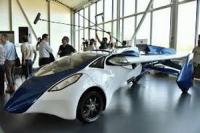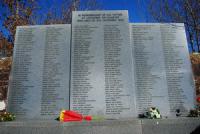-
Structures Near Airports Increase Risk of Airplane-Goose Collisions
From mid-November 2015 through February 2016, scientists used GPS transmitters to track the movements of Canada geese near Midway International Airport in Chicago. They discovered that – in the colder months, at least – some geese are hanging out on rooftops, in a rail yard and in a canal close to Midway’s runways. This behavior increases the danger of collisions between geese and airplanes, the researchers say.
-
-
Sniffing Out Signs of Trouble
A NIST researcher is conducting the first field test of a high-tech sniffing device called a PLOT-cryo — short for “porous layer open tubular cryogenic adsorption.” This NIST-invented device can be used to detect very low concentrations of chemicals in the air. The technology offers a new way to screen shipping containers at ports of entry.
-
-
Keeping TSA Detection Systems in Check
As the Transportation Security Administration (TSA) screens nearly two million people each day, officers are faced with the challenge of finding even the smallest sign of a threat. Microscopic particles of explosives can cling to a nefarious actor despite their best intentions to conceal any evidence of hidden contraband on their person or in their bags. S&T chemist Dr. Jim Deline developed a novel method to more efficiently test TSA detection equipment.
-
-
Cybersecurity of Connected Autonomous Vehicles
In the near future connected and autonomous vehicles (CAVs) are expected to become widely used across the world. Researchers have been working to improve the security, privacy and safety of CAVs by testing four innovations in the IoT-enabled Transport and Mobility Demonstrator. They were able to connect CAVs to other CAVs and roadside infrastructure more securely and privately.CAVs can now connect to each other, roadside infrastructure, and roadside infrastructure to each other more securely.
-
-
Faster, Smarter Security Screening Systems
By now, attendees to sporting events, visitors to office buildings, and especially frequent fliers are all quite familiar with the technologies used at security checkpoints. You arrive at the security checkpoint, check your bags, show your ID and maybe your ticket or boarding pass, throw away the coffee or water you’ve been chugging, and then wait in a long line until it is your turn to be screened. The security lines can be inconvenient. S&T and partners are working to help security screening systems, whether at airports, government facilities, border checkpoints, or public spaces like arenas, to work faster and smarter.
-
-
Tackling Cargo Shipping Security
Each day, thousands of containers travel the globe. Security agencies need to ensure the cargo that originally was shipped in them is what is in them when they reach their destination. Harmful or illegal content, added after the cargo was cleared for transport, must be detected and intercepted. Securing the global supply chain, while ensuring its smooth functioning, is essential to U.S. national security.
-
-
Returning Airships to the Skies
The transport sector is responsible for around 25 percent of global CO2 emissions caused by humans. Reintroducing airships into the world’s transportation-mix could contribute to lowering the transport sector’s carbon emissions and can play a role in establishing a sustainable hydrogen-based economy.
-
-
Assessing the Danger of Drone Strike
The rapid rise in the number of drones worldwide has been accompanied by increasing reports of near misses with commercial aircraft. Bird-strike tests for aircraft are mandatory, but to date, however, there is no equivalent standard test procedure for collisions with drones.
-
-
Hezbollah operative collected sensitive information about Toronto Airport for potential future attack
An operative for the Iranian-backed terrorist organization Hezbollah collected “detailed information” about Toronto’s Pearson airport, according to a report released by Canada’s air safety agency on Tuesday. The Hezbollah operative also scouted New York’s JFK airport and U.S government facilities, as well as identifying Israelis in the United States who could be targeted by the Iranian-sponsored terrorist group.
-
-
Shoe scanner may improve airport security
The types of shoes you wear when flying matter. And not just shoe types. Size, material, soles and heels are also very important. Why? Shoes can become dangerous vehicles for terrorists’ plots. DHS wants to prevent future incidents, and this is why S&T is working on a millimeter wave technology for screening shoes as part of the larger Screening at Speed Program.
-
-
Hawk’s pursuit technique can help counter-drone defenses
Hawks steer their pursuit of evasive prey using a feedback system that differs fundamentally from the missile-like interception system of falcons.
-
-
Flying cars: automating the skies means playing with our lives

Recent research suggests that flying cars could eventually be a sustainable way to free up roads. The first models are set to hit our skies in 2019 as personal playthings, while industry sees them as taxis and commuter vehicles of the future. But as Harry Potter’s encounter with the Whomping Whillow reminds us, flying cars can be dangerous. Before futuristic visions of three-dimensional sprawling city traffic can approach reality, there are some serious safety issues that need addressing.
-
-
Flying colors: Assessing the role of flying cars in sustainable mobility

A new study of the environmental sustainability impacts of flying cars, formally known as electric vertical takeoff and landing aircraft, or VTOLs, finds that they wouldn’t be suitable for a short commute. However, VTOLs—which combine the convenience of vertical takeoff and landing like a helicopter with the efficient aerodynamic flight of an airplane—could play a niche role in sustainable mobility for longer trips.
-
-
Former East German agents questioned in Lockerbie bombing probe

Hundreds were killed when Pan Am Flight 103 exploded over the Scottish village of Lockerbie in December 1988. Libya later took responsibility and paid compensation to the victims’ families — and one of its secret agents spent eleven years in jail for the attack. Scottish and German investigators, acting on newly revealed information, are now looking onto the possibility that agents of STASI — East Germany’s secret police — were involved.
-
-
Securing drone traffic

In a couple of years, the number of drones in the U.S. national airspace is projected to grow to more than seven million. So many drones together in the air at once has the potential to create serious safety, efficiency and security issues if not regulated. The Unmanned Aircraft Systems Traffic Management (UTM) infrastructure will manage national airspace drone traffic in the future, and it is being rolled out in phases over time.
-
More headlines
The long view
New Technology is Keeping the Skies Safe
DHS S&T Baggage, Cargo, and People Screening (BCP) Program develops state-of-the-art screening solutions to help secure airspace, communities, and borders
